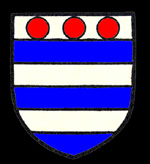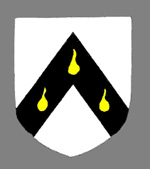The Manor of Milton Ernest alias Harnesse

The de Grey coat of arms
Volume III of The Victoria County History for Bedfordshire was published in 1912. The work gave detailed histories of every manor in the county. The Domesday Book of 1086 tells us that the parish was then divided into six separate holdings. The Manor of Milton Ernest alias Harnesse probably originated in three hides, one virgate held in 1086 by the wife of Hugh de Grandmesnil with her tenant being her husband's steward, Ivo.
There is then a gap in knowledge until the 13th century when the overlord was the Earl of Leicester and the tenants were the de Grey family. When Simon de Montfort, Earl of Leicester and rebel against King Henry III (1216-1272) was killed at the Battle of Evesham his estates were taken by the Crown and King Henry gave them to his younger son Edmund de Montfort, earl of Leicester and Lancaster, whose son Thomas died without heirs. Thomas' brother Henry succeeded him and was holding the manor in 1330. By 1346, however, the overlordship had passed to the tenants, the de Greys. The overlordship is last mentioned in 1528 when held by John Zouche, heir of Henry, 7th Baron Grey de Ruthyn and 4th Earl of Kent.

The Erneys family coat of arms
The de Greys' tenants were the Erneys or Hernis family, from whom the manor took its name. The first member of the family recorded is a Robert son of Ernis in 1221. In 1279 John, son of Roger Erneys held six and a half virgates from the de Greys as well as a third of the fishing on the Great Ouse as far as the mill pond. By 1346 John Erneys was tenant of the de Greys and the first member of the family to be specifically called tenant of the manor was Philip Erneys in 1471.
The manor remained in the Erneys family until the mid 16th century when it was divided between the three daughters of Walter Erneys, who is known still to have been alive in 1550. They married into the Turnor, Strange and Keale families. In 1575 Sybil Keale quitclaimed her third of the manor to Edmund Turnor. These two thirds of the original manor thence became known as the Manor of Milton Ernest.

The coat of arms of the Turnor family of Stoke Rochford
Edmund Turnor was succeeded by his son Christopher, who died in 1619. His son, another Christopher, was deprived of his estates for delinquency, but they were restored to him in 1647. On the Restoration of Charles II (1660-1685) he was knighted and created Third Baron of the Exchequer. He died in 1675. The manor remained in his family until 1715 when Edmund Turnor of Stoke Rochford alienated the manor to his cousin Streynsham Master. The manor was later owned by Elizabeth Stuckley, a sister of Masters [BS33], and she left it in her will to Withers Bramston, who was Lord of the Manor in 1799, the year it was sold by Arthur Bramston to Robert Giddins.
By 1864 the Lord of the Manor was Adelbert Wellington Brownlow Home-Cust, 3rd Baron Brownlow but by 1869 the manor was in the hands of a man named Tucker, who was succeeded by his daughter, who had married Burton Alexander. Their son J. Tucker Burton Alexander was Lord of the Manor in 1912. A succession of Law of Property Acts in the 1920s extinguished all manorial incidents, courts and copyhold tenure of land. This effectively abolished manors in all but name.
The third of the manor devised in the mid 16th century to Margaret Strange was sold after her death by her husband to Thomas Rolt in 1562. Margaret's heirs, when they came of age disputed the sale but eventually, in 1571, Walter Strange quitclaimed the manor to Rolt who added it to the Manor of Bassets.